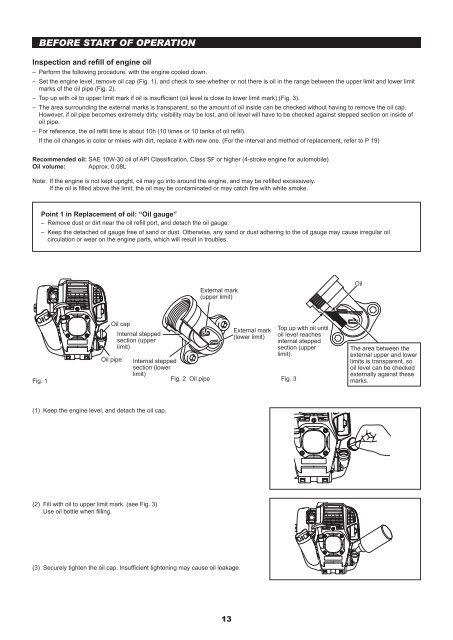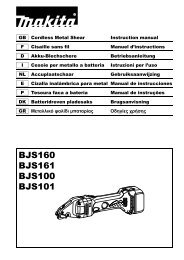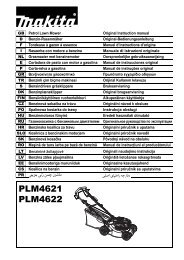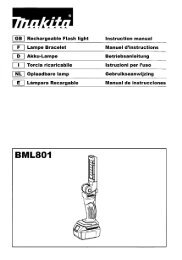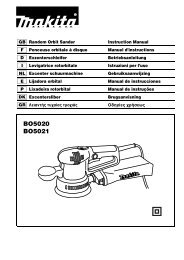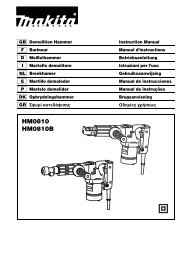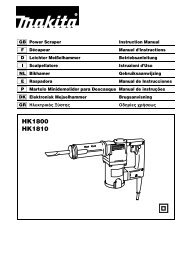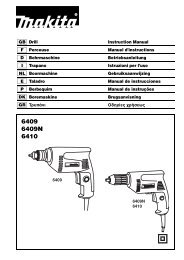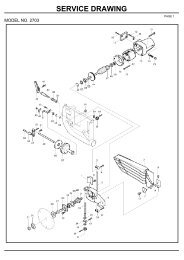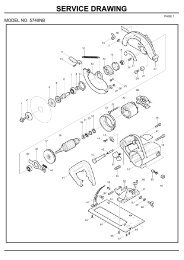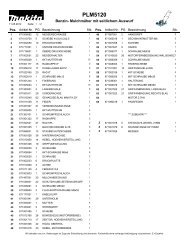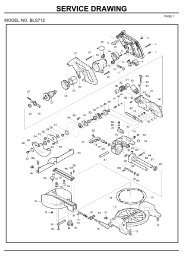Original Instruction Manual Instructions d'emploi d'origine ... - Makita
Original Instruction Manual Instructions d'emploi d'origine ... - Makita
Original Instruction Manual Instructions d'emploi d'origine ... - Makita
You also want an ePaper? Increase the reach of your titles
YUMPU automatically turns print PDFs into web optimized ePapers that Google loves.
BEFORE START OF OPERATION<br />
Inspection and refill of engine oil<br />
– Perform the following procedure, with the engine cooled down.<br />
– Set the engine level, remove oil cap (Fig. 1), and check to see whether or not there is oil in the range between the upper limit and lower limit<br />
marks of the oil pipe (Fig. 2).<br />
– Top up with oil to upper limit mark if oil is insufficient (oil level is close to lower limit mark) (Fig. 3).<br />
– The area surrounding the external marks is transparent, so the amount of oil inside can be checked without having to remove the oil cap.<br />
However, if oil pipe becomes extremely dirty, visibility may be lost, and oil level will have to be checked against stepped section on inside of<br />
oil pipe.<br />
– For reference, the oil refill time is about 10h (10 times or 10 tanks of oil refill).<br />
If the oil changes in color or mixes with dirt, replace it with new one. (For the interval and method of replacement, refer to P 19)<br />
Recommended oil: SAE 10W-30 oil of API Classification, Class SF or higher (4-stroke engine for automobile)<br />
Oil volume: Approx. 0.08L<br />
Note: If the engine is not kept upright, oil may go into around the engine, and may be refilled excessively.<br />
If the oil is filled above the limit, the oil may be contaminated or may catch fire with white smoke.<br />
Point 1 in Replacement of oil: “Oil gauge”<br />
– Remove dust or dirt near the oil refill port, and detach the oil gauge.<br />
– Keep the detached oil gauge free of sand or dust. Otherwise, any sand or dust adhering to the oil gauge may cause irregular oil<br />
circulation or wear on the engine parts, which will result in troubles.<br />
(1) Keep the engine level, and detach the oil cap.<br />
(2) Fill with oil to upper limit mark. (see Fig. 3)<br />
Use oil bottle when filling.<br />
External mark<br />
(upper limit)<br />
Oil cap<br />
Internal stepped<br />
section (upper<br />
limit)<br />
External mark<br />
(lower limit)<br />
Top up with oil until<br />
oil level reaches<br />
internal stepped<br />
section (upper<br />
limit).<br />
Oil pipe Internal stepped<br />
section (lower<br />
Fig. 1<br />
limit)<br />
Fig. 2 Oil pipe Fig. 3<br />
(3) Securely tighten the oil cap. Insufficient tightening may cause oil leakage.<br />
13<br />
Oil<br />
The area between the<br />
external upper and lower<br />
limits is transparent, so<br />
oil level can be checked<br />
externally against these<br />
marks.


